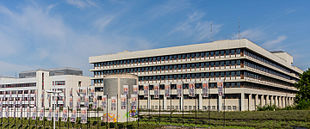State Authority House
The state authority building is an office building in the Gronau district of Bonn , which was built in the early 1970s. Until 2006 it was the seat of the Bonn Police Headquarters .
location
The building is located in the federal district on the southern edge of the Gronau district on the west side of Friedrich-Ebert-Allee ( B 9 ) at number 144, northwest of the intersection with the 562 federal motorway .
history
The state authority building was built between 1970 and 1974 based on a design by the architects Ernst van Dorp , Rolf Altmann, Kurt Kleefisch and Eberhard Rüttgers, who had joined forces to form the Bonn Architects' planning ring . The topping-out ceremony was celebrated on February 26, 1973. In addition to the police headquarters - previously located at Koblenzer Strasse 134 (today Adenauerallee ) - it also housed the State Building Department , the State Trade Inspectorate , the Office for Agricultural Regulations and the State Office for Water and Waste Management . And the construction of other state agencies, including the originally planned at this location Finanzamt Bonn-Außenstadt and in the northern city (domiciled judicial authorities country - and district court ). A realization competition was carried out for this in 1978/79 , the results of which, however, led to a legally binding development plan only in the mid-1980s due to the problematic development of the site and were ultimately discarded due to new priorities being set in the meantime. The state authority building was not expanded until 1991 on the rear side, facing the railway line on the left bank of the Rhine , but not for judicial and financial authorities. In the 1990s, the Office for Agricultural Regulations and the State Building Office moved out of the state authority building.
Since Bonn was the seat of government of the Federal Republic of Germany until 1999 , the Bonn Police Headquarters also had the " Personal and Property Protection " (POS) unit with around 700 officers, which was the largest police station in North Rhine-Westphalia at the time. After their dissolution and the general downsizing in Bonn police headquarters from around 2500 to around 1150 positions (as of 2006), a large part of the office space of the state authorities was no longer used. The country therefore planned to give up the property. The State Environment Agency was relocated to Bad Godesberg in the summer of 2006 , and in October 2006 the police headquarters moved to a newly constructed building in the Ramersdorf district on the right bank of the Rhine . In 2006/07, the Bonn-based real estate company IVG planned to buy the now vacant state authority building and to tear it down for the construction of new office buildings. After these plans failed, the property is still owned by the state of North Rhine-Westphalia; the original building from 1970-74 was gutted . In spring 2011, the Institute for Computer Science at the University of Bonn moved into the extension from 1991 on a temporary basis (until autumn 2017), further tenants were (as of 2014) the Institute for Crop Science and Resource Conservation (INRES) at the University of Bonn and the Fraunhofer Institute for Communication, information processing and ergonomics ( Fraunhofer FKIE) as sub-tenant of the University of Bonn. Fraunhofer FKIE moved into a new institute location in 2016. The location of the state authority building is also being considered for the settlement of the city administration.
architecture
The original building of the state authorities' building, completed in 1974, is a six-storey, about 120 m long exposed concrete building on pillars , which encloses two inner courtyards . It is connected to the extension from 1991 by a glazed corridor. The development of the ground floor with the central input is through double-sided ramps. The building also includes a gym, gymnastics rooms and a former car workshop.
literature
- Andreas Pellens: A Bonn native builds. Ernst van Dorp 1950-2000 . Bouvier-Verlag, Bonn 2002, ISBN 978-3-416-03033-5 , pp. 118/119.
- Karl-Heinz van Kaldenkerken , City Director Bonn (Ed.); Friedrich Busmann : Expansion of the federal capital. 10 years capital city agreement 1975–1985 . Bonn 1986, pp. 90-92.
Web links
Individual evidence
- ↑ Horst Fehre: Bonn on the way to the real capital . In: Address book of the federal capital Bonn , 93rd edition, JF Carthaus, Bonn 1974, pp. XXI – XXVII (here: p. XXII.) ( Online )
- ^ The Federal Republic of Germany: Part of the Land Nordrhein-Westfalen , C. Heymanns, 1967, p. 28.
- ↑ The Lord Mayor of Bonn (Ed.); Friedrich Busmann : From the parliament and government district to the federal district. A Bonn development measure 1974-2004 . Bonn, June 2004, p. 62.
- ↑ Terror, Castor, Euro and Fewer and Fewer People , General-Anzeiger , October 22, 2001
- ^ Bonn group buys the state authority building , General-Anzeiger, July 29, 2006
- ↑ The state authority building will not be sold until 2008 , General-Anzeiger, August 29, 2006
- ↑ Old Presidium: Sale is off the table , Kölnische Rundschau , February 10, 2011
- ^ Projects for the future of the University of Bonn , General-Anzeiger , March 28, 2017
- ↑ LANDTAG NORTH RHINE-WESTPHALIA Printed matter 16/14150 , January 31, 2017
- ↑ Fraunhofer-FKIE strengthens Bonn as a national center for cybersecurity , June 2, 2016
- ↑ Almost too good to be true , General-Anzeiger, February 9, 2010
- ↑ The waves run high , General-Anzeiger , 26 January 2016
- ^ City is looking for alternatives for sports halls , General-Anzeiger , January 28, 2016
Coordinates: 50 ° 42 ′ 22.5 ″ N , 7 ° 7 ′ 48.6 ″ E

